Avid hikers understand that maintaining dry feet is paramount for a comfortable and safe outdoor adventure. The inconvenience of wet feet is not only discomforting but can also lead to more serious issues like blisters, fungal infections, and trench foot.
In this discussion, we will explore ten practical tips that can assist you to keep your feet dry while hiking. From selecting the right socks and boots to foot care routines, these strategies are designed to enhance your hiking experience.
As we navigate through these tips, you will discover the intricacies of each approach and how you can integrate them into your hiking routine.
Key Takeaways
- Choose socks made from moisture-wicking materials like merino wool or synthetic fabrics to reduce friction and the risk of blisters.
- Properly maintain and clean your waterproof boots to ensure their functionality and durability.
- Use various methods like air drying and specialized products to dry your boots and prevent moisture build-up.
- Airing your feet and allowing them to dry during breaks helps prevent moisture-related complications and enhances comfort.
Choosing the Right Socks
When embarking on a hiking adventure, the choice of socks is pivotal, and selecting those made from moisture-wicking materials such as merino wool or synthetic fabrics can significantly enhance your comfort and foot health. The best hiking socks are those that effectively transport sweat away from your feet, reducing friction and the risk of developing blisters or experiencing discomfort.
Despite their comfort in everyday wear, cotton socks are not suitable for hiking. They retain moisture and fail to dry quickly, leading to dampness that can result in painful blisters and an overall uncomfortable hike. Conversely, merino wool and synthetic fabrics offer superior moisture-wicking abilities – they pull sweat away from your skin, keeping your feet dry and comfortable throughout your journey.
Your pair of hiking socks plays a critical role in your overall hiking experience. Investing in a pair made from merino wool or synthetic fabrics can make the difference between a painful, blister-ridden hike and a comfortable, enjoyable adventure. Remember, the right socks not only enhance your comfort but also play a pivotal role in maintaining your foot health. Choose wisely.
Proper Hiking Boots Maintenance
In addition to selecting the right socks, maintaining your hiking boots properly is essential for keeping your feet dry and extending the life of your footwear. Proper hiking boots maintenance is not just about preserving their appearance, but also about ensuring their functionality. Your waterproof boots are your best allies on the trail; take care of them, and they'll take care of you.
To evoke a sense of belonging and shared responsibility, consider the following steps for boot maintenance:
- After each hike, clean your boots to remove dirt and debris. This helps to maintain the waterproof protection that keeps your feet dry while hiking.
- Regularly re-waterproof, wax, or condition your boots. Consider products like Nikwax Fabric and Leather Proof or Grangers G-Wax and Leather Conditioner. These products offer:
- Restorative properties, extending the life of your boots.
- Waterproofing benefits, keeping your feet dry in all conditions.
Techniques for Drying Your Boots
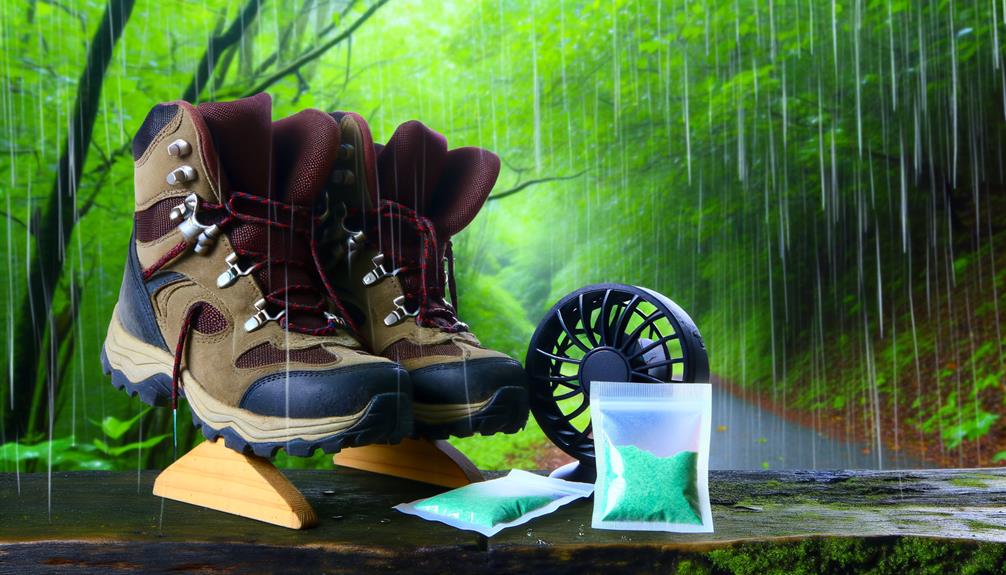
Balancing the need for dry boots with the care required to protect their durability is an essential part of hiking preparation.
Various methods can be employed to dry your boots, from air drying to the use of specialized products.
Additionally, prevention of moisture build-up is key to maintaining the comfort and longevity of your boots, reinforcing the adage that prevention is better than cure.
Boot Drying Methods
Mastering the art of boot drying methods is essential to hiker's comfort and overall foot health. Techniques range from removing insoles and loosening laces to allowing boots to thoroughly dry in a well-aired room. These methods not only maintain the structural integrity of your boots but also keep your feet healthy by preventing moisture build-up that can lead to blisters or infections.
Consider using:
- Dry socks: these can absorb excess moisture, keeping your feet dry and comfortable.
- Waterproof membrane boots: these offer an extra layer of protection against wet conditions.
Prevention Over Cure
Opting for moisture-wicking hiking socks made from materials such as merino wool or synthetic fabrics is an effective strategy to keep your feet dry and reduce friction while on the trail. To illustrate, consider the following table:
| Prevention Techniques | Description | Impact |
|---|---|---|
| Moisture-wicking socks | Made from merino wool or synthetic fabrics | Reduces friction and moisture |
| Air-dry boots | Remove insole and loosen laces after hiking | Prevents moisture buildup and damage |
| Foot-rest breaks | Remove boots and socks during breaks | Reduces chance of blisters |
| Waterproof socks and gaiters | Worn in wet conditions | Compensates for failing boot waterproofing |
| Elevating feet | Done during meal breaks and bedtime | Relieves foot pain and reduces swelling |
These simple but practical steps embody 'prevention over cure', ensuring your hiking experience remains enjoyable.
Essential Boot Maintenance
Maintaining the condition of your hiking boots is an integral part of ensuring dry feet on the trail. One crucial aspect of this is learning proper boot drying techniques. Essential boot maintenance includes preventive measures such as using Fabric and Leather Proof for waterproofing and drying your boots properly after each hike.
Steps to dry your hiking shoes:
- Remove the insole and loosen the laces.
- Allow boots to air dry in a well-ventilated area.
Tips for maintaining waterproof boots and socks:
- Avoid placing near a radiator or fire to prevent damage.
- Regular drying helps maintain waterproof capabilities and extend lifespan.
Importance of Airing Your Feet
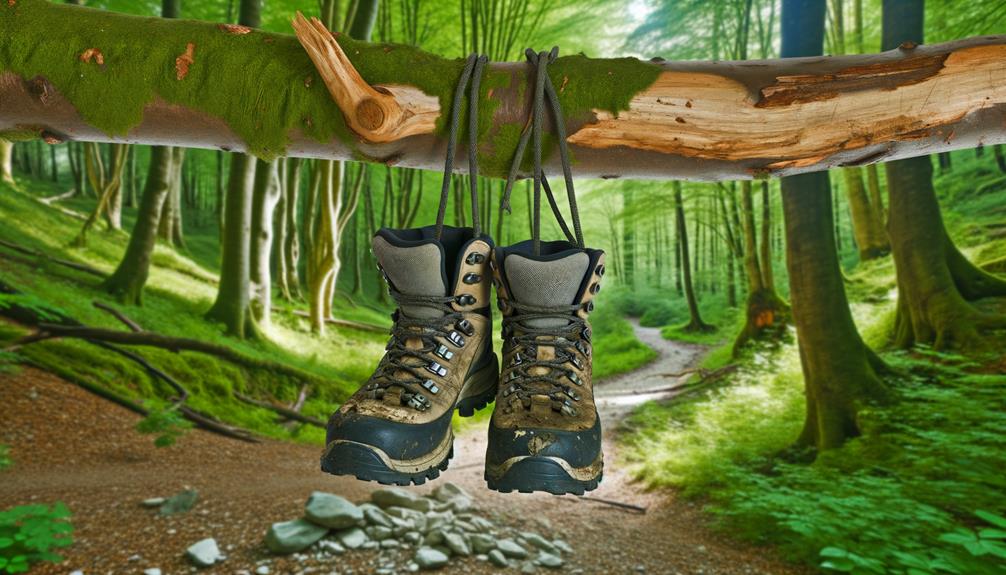
The significance of airing your feet during hiking activities cannot be overstated.
This practice not only aids in efficiently drying the feet, but also mitigates the risk of moisture-related complications such as foot fungus, cracked skin, and trench foot.
Furthermore, airing your feet enhances comfort, potentially enriching your overall hiking experience.
Benefits of Foot Air-Drying
Understanding the benefits of foot air-drying during hiking excursions is crucial, as it not only provides relief to feet that have been confined in shoes all day, but also helps prevent conditions such as blisters, foot fungus, cracked skin, and bleeding.
The benefits of foot air-drying include:
- Enhanced comfort: By keeping feet dry while hiking, you'll feel more at ease and be able to enjoy your trek more.
- Prevention of foot conditions: Regular airing of your feet deters the development of blisters, foot fungus, and other uncomfortable conditions.
Proper use of foot powder can assist in maintaining dry feet.
Preventing Moisture-Related Issues
To prevent moisture-related issues during hiking excursions, it's vital to allow your feet ample time to air out during breaks, significantly reducing the accumulation of sweat and the risk of developing discomforting blisters.
It is a practical and effective strategy to remove your hiking boots and wet socks, exposing them to sunlight to absorb moisture. Simultaneously, keep an extra pair of dry socks to change into, furthering the process of keeping your feet dry and preventing blisters.
Airing your feet and socks not only enhances comfort but also helps prevent complications from moisture buildup.
After the hike, ensure to thoroughly dry your boots, as this prevents any residual moisture from causing potential damage.
The Advantage of Waterproof Socks
Navigating damp trails and crossing shallow streams can become significantly more comfortable with the strategic use of waterproof socks, a hiking essential designed to maintain dry and comfortable feet. These particular socks pose a significant advantage, allowing hikers to 'wear waterproof' and ensure that their feet stay dry, regardless of the terrain or weather conditions.
The advantage of waterproof socks extends beyond just keeping your feet dry while hiking. They also compensate for failing boot waterproofing, providing an added layer of protection against wet feet.
Emotionally, the benefits of waterproof socks can be categorized as follows:
- *Physical Comfort:*
- Reduced friction and discomfort from wet socks
- Prevention of blister formation
- *Psychological Assurance:*
- Confidence in tackling various hiking terrains
- Peace of mind knowing your gear can handle the elements
Investing in a pair of waterproof socks can dramatically improve the hiking experience. By creating a balance of physical comfort and mental assurance, hikers can focus more on the journey, the companionship, and the beauty of nature, rather than worrying about keeping their feet dry.
Selecting Tall Boots and Gaiters
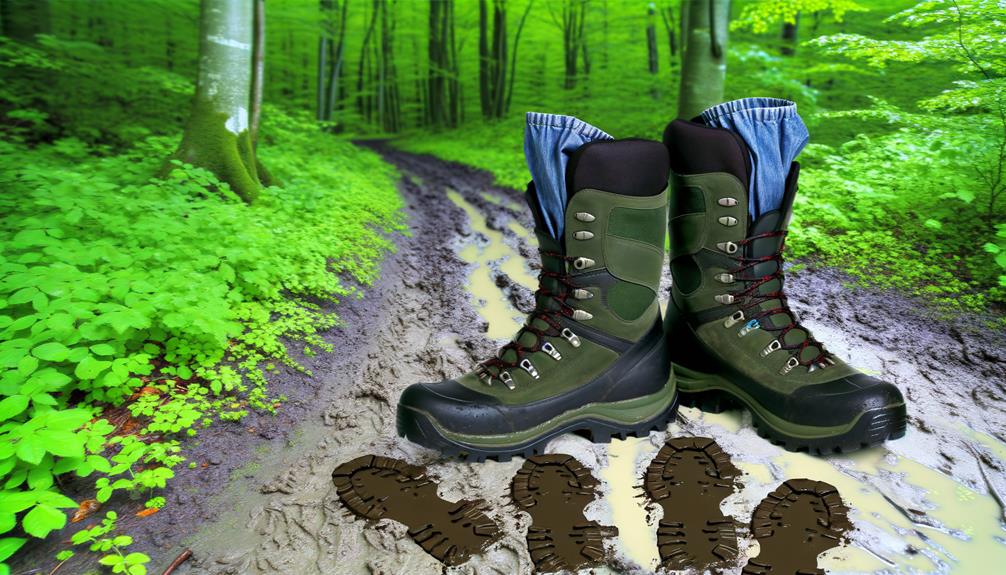
When embarking on a hiking journey in wet conditions, the careful selection of tall boots and gaiters can provide an additional layer of comfort and protection, ensuring that your feet remain dry throughout your adventure.
One essential tip to remember when selecting tall boots is to choose those with waterproof-breathable membranes like Gore-Tex or eVent. These boots offer effective water protection, an essential feature when hiking in damp or rainy conditions.
Gaiters, an often overlooked accessory, play a crucial role in keeping your feet dry. They cover the lower leg, ankle, and most of the boot, preventing water from entering your footwear. Look for gaiters with multiple layers and Velcro closures for better protection against water and debris.
To maximize the effectiveness of your gaiters, wear them under your rain pants. This strategy helps prevent rain from seeping in through the top and ensures you keep your feet dry, even in the harshest conditions.
Preparing Your Feet Before Hiking
Beyond the crucial selection of waterproof footwear and gaiters, preparing your feet before hiking is another pivotal step to ensure dryness and overall foot health during your trek. Remember that a pair of well-prepared feet is your best ally on a long hike.
Proper foot preparation begins with the right socks. Wear the right type – one that wicks away moisture and provides cushioning. Next, soak your feet in Epsom salts for 20 minutes. This not only relaxes your feet but also helps to eliminate toxins.
To further prepare, consider the following:
- Conditioning: Use a product like Trail Toes. This will reduce friction and prevent blisters.
- Keep your feet moisturized and pliable. Hydrated skin is less prone to blisters and cracking.
- Toenail Care: Trim your toenails straight across and avoid trimming them too short to prevent ingrown nails.
- Consider filing the nails to prevent sharp edges that can snag your socks.
Preparing your feet before hiking is not just a requirement but a ritual of belonging to the hiking community. It is a proven approach to enjoy discomfort-free hikes and keep your feet dry and healthy throughout your journey.
Addressing Shoe Discomfort Immediately
When hiking, immediate attention to shoe discomfort can prevent minor irritations from escalating into more serious issues. This can be achieved by promptly addressing hot spots, keeping feet dry, and removing any foreign objects from your shoes.
Proper toenail care, along with the use of support insoles, can further enhance comfort and mitigate fatigue.
Recognizing Shoe Problems
Detecting and addressing shoe discomfort promptly during a hike is crucial to prevent exacerbation of minor irritations into more serious foot problems. Recognizing shoe problems can be straightforward if you're mindful. If you feel a hot spot or notice your trail runners are rubbing uncomfortably, don't wait until the end of the day to address it.
- Be proactive:
- Carry an extra pair of socks for a quick change
- Pack blister prevention aids like moleskin or leukotape
- Be reactive:
- Stop and adjust your laces or socks at the first sign of discomfort
- Apply foot balm or other blister treatments as needed
Quick Discomfort Solutions
In the event of an unforeseen shoe discomfort during a hike, immediate action is essential to prevent minor irritations from escalating into major foot issues. Quick discomfort solutions can ensure dry, comfortable feet throughout the journey.
Start by removing any foreign objects from your shoes as soon as they are noticed. Use Leukotape or foot balm to treat hot spots immediately, keeping skin protected and dry.
Opt for thick socks, preferably wool socks, to absorb moisture and reduce friction. During breaks, elevate your legs to improve circulation and alleviate discomfort.
For multi-day hikes, rinse and care for your feet regularly. Finally, consider using anti-chafing products for immediate relief from discomfort.
The Role of Anti-Chafing Products
The effective use of anti-chafing products, such as Trail Toes cream, plays a pivotal role in preventing friction and discomfort during hiking. These products are formulated to create a protective barrier on the skin, reducing the painful effects of friction that can occur during a long trail or backpacking trip.
Consider using anti-chafing products in the following ways:
- Before setting off on your hike, pre-condition your feet with the cream. This helps keep your feet comfortable and reduces the risk of blisters.
- Reapply during the day if you feel a hot spot developing.
- If your feet got wet during the day, apply the cream at night to prevent chafing.
These products are not only for feet but can also be used on other areas of the body prone to chafing for added protection.
As a community of hikers, we share the common goal of an enjoyable and pain-free hiking experience. The use of anti-chafing products contributes to this goal, ensuring that we can focus on the beauty of the trail rather than any discomfort.
Proper Toenail Trimming and Care
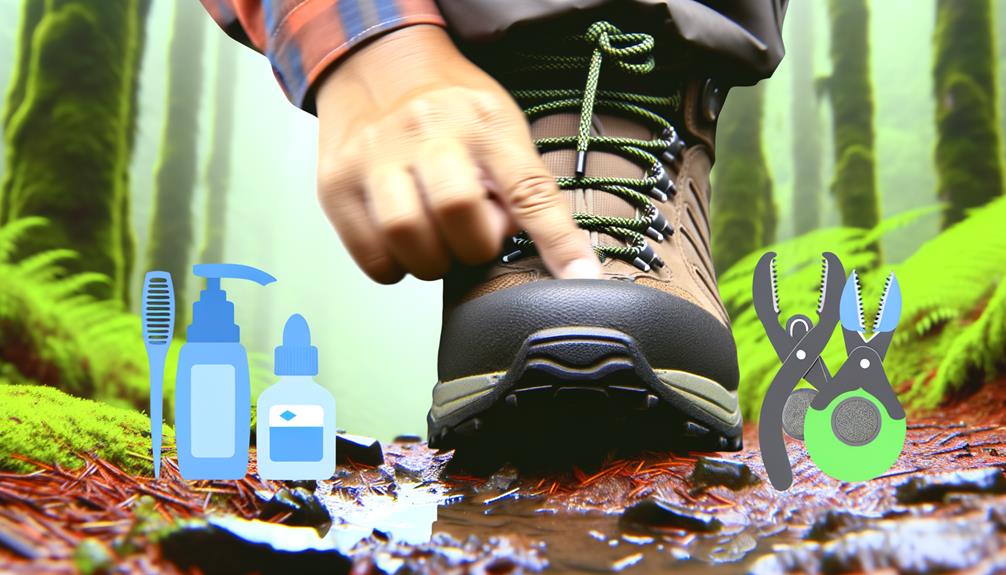
Maintaining foot health and comfort during hiking necessitates proper toenail trimming and care, a task that is often overlooked yet critical for preventing foot issues on the trail. Properly trimmed and cared for toenails ensure that discomfort and complications, such as ingrown toenails and blisters, are kept at bay during your hiking trip.
Start by trimming your toenails straight across, making sure not to cut them too short as this can lead to painful ingrown nails. Ideally, your toenails should be even with the tips of your toes. This simple but important step in foot care can dramatically improve the comfort of your hiking shoes and socks, especially during longer treks.
In terms of care, keep your toenails clean and dry to avoid fungal infections. This becomes particularly important when hiking in wet conditions. Consider investing in quality hiking socks like Darn Tough, which are designed to wick moisture away, helping to keep your feet and toenails dry.
With proper toenail trimming and care, you are one step closer to a comfortable and enjoyable hiking experience.
Frequently Asked Questions
How Do Hikers Keep Their Feet Dry?
Hikers keep their feet dry through smart sock selection, appropriate footwear choices, terrain considerations, weather preparations, and good hygiene habits. Careful planning and maintenance can ensure comfortable, moisture-free hiking experience.
How to Waterproof Feet?
To waterproof feet, consider utilizing waterproof socks and DIY sealants. Smart footwear choices, such as moisture-resistant shoes, are essential. Natural remedies can offer additional protection. Lastly, learn wet weather hacks for unexpected rainfalls.
How Do I Prepare My Feet for a Long Hike?
Preparing for a long hike involves careful footwear selection, appropriate sock choices, pre-hike exercises, blister prevention measures, and maintaining foot hygiene. These steps ensure comfort, dryness, and prevention of common foot complications during the hike.
What Is the Foot Spray for Hiking?
Foot spray for hiking, formulated with specific ingredients, offers an effective solution to keep feet dry. Considering potential allergic reactions, finding the best brands is crucial. Regular application enhances its effectiveness during long hikes.
Conclusion
In conclusion, maintaining dry feet during hiking expeditions is attainable through several strategic practices. Essential actions, such as proper sock and boot selection, routine maintenance, and foot care, can significantly mitigate adverse effects.
Additionally, immediate responsiveness to discomfort, use of protective accessories, and appropriate foot preparation can further enhance comfort. Ultimately, these guidelines, if diligently followed, can contribute to an enjoyable, comfortable, and blister-free hiking experience.
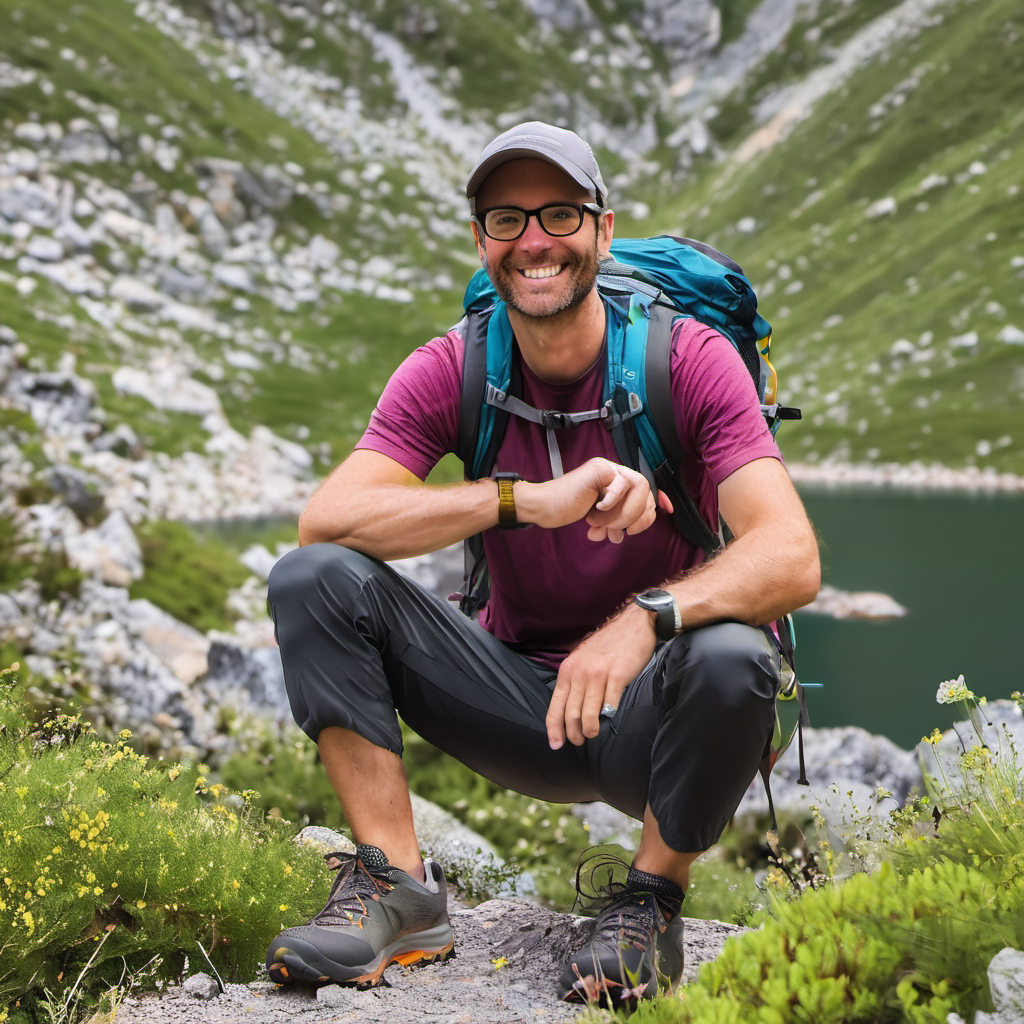
With years of extensive experience, I specialize in evaluating waterproof hiking shoe options across various brands. My goal is to offer valuable insights and recommendations, enhancing your hiking experience with tips and suggestions for a more adventurous and comfortable journey.

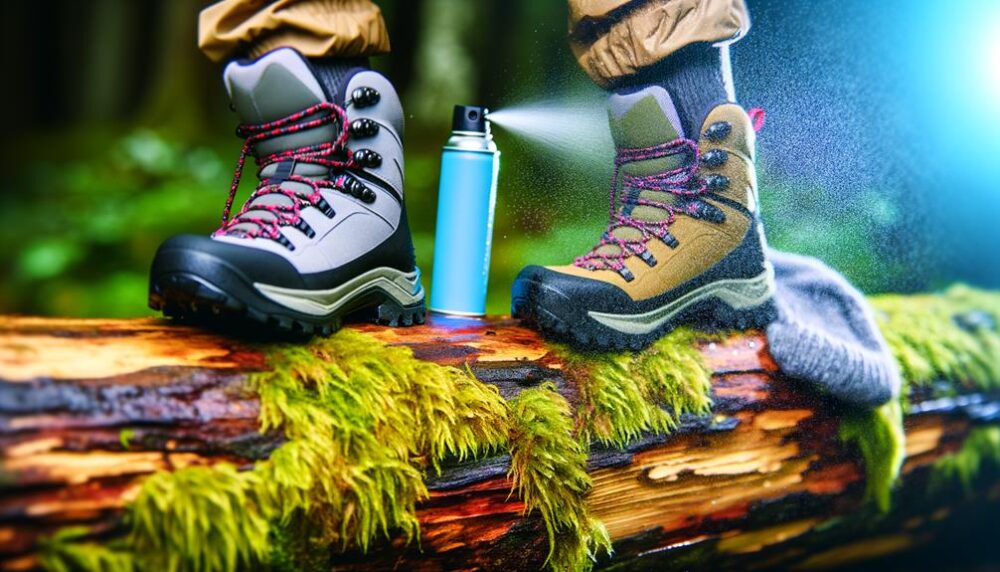
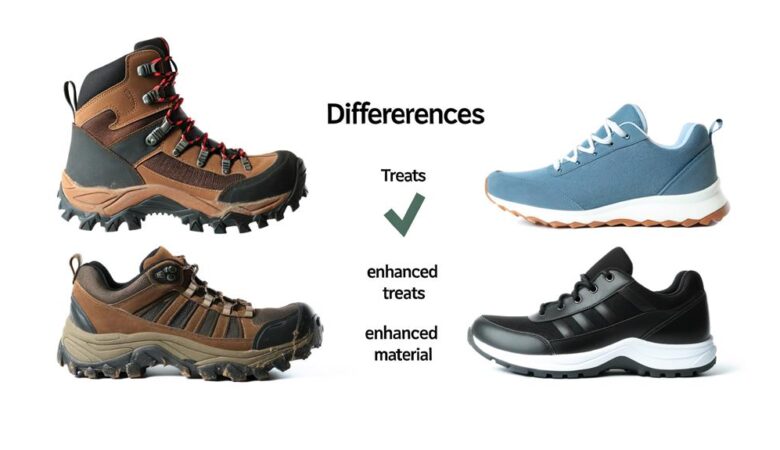
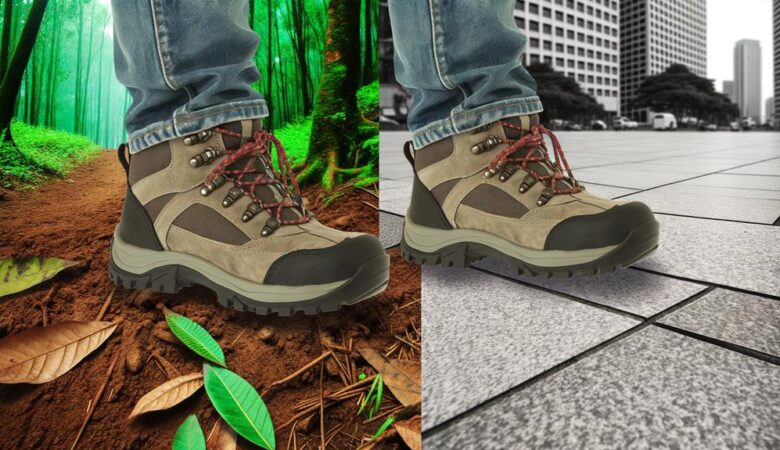
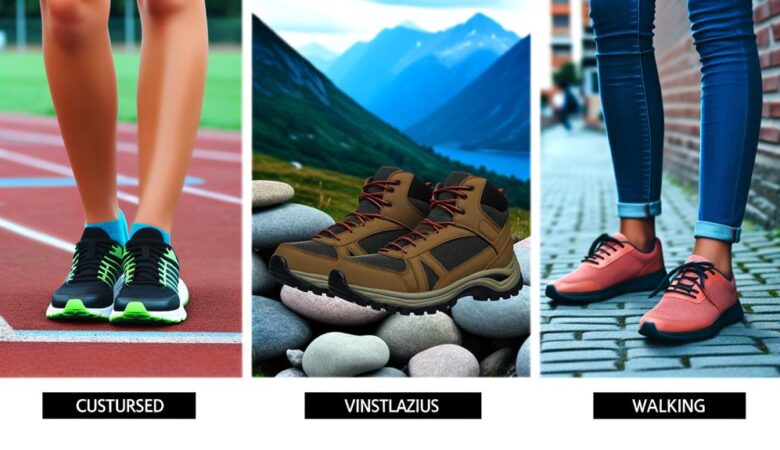
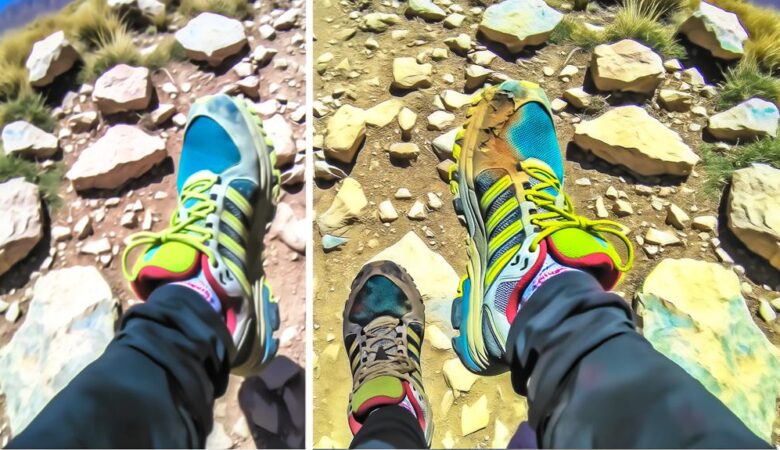
Leave a Reply